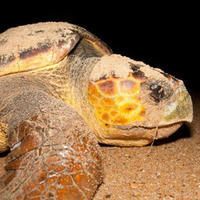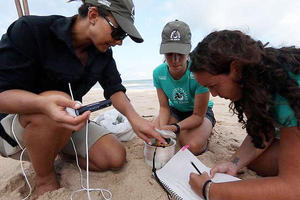Oceanographer finds female turtles outnumbering males
Rising global temperatures may skew gender imbalance among the marine turtle population, according to new Florida State University research.

A Brazilian loggerhead turtle. (Image courtesy Projecto Tamar)
Mariana Fuentes, an assistant professor in FSU's Department of Earth, Ocean and Atmospheric Science, and a team of Brazilian researchers have been examining Brazilian loggerhead turtles to see how rising temperatures affect that species. The sex of marine hatchlings is influenced by incubating temperatures, and warmer temperatures produce a higher number of female hatchlings.
Researchers believe projected increases in temperature will cause a gender imbalance in marine turtle populations and are trying to identify best practices to protect the species.
“We’re concerned we’re going to have a feminization of marine turtles,” Fuentes said. “This study came from the need to understand the current sex ratio being produced at loggerhead nesting grounds to establish baseline parameters as climate change progresses and to identify beaches that produce a higher proportion of males.”
Fuentes and her team were specifically trying to identify beaches that produce higher numbers of male turtles, so they could get a broader view of areas where imbalances were already occurring.
In northern Brazil, an exceptionally strong female bias — 94 percent — was observed in all nesting areas used by loggerhead turtles. But, scientists were also able to identify nesting beaches in southern Brazil that were producing a higher proportion of male hatchlings — 47 percent — which is essential to sustain the population.
“It’s worrying that you could have an extreme skew in gender one way,” Fuentes said. “Any changes in population structure can have real repercussions.”

Assistant Professor Mariana Fuentes, left, and her team researched 21 nesting sites in Brazil.
The research is published in the Journal of Experimental Marine Biology and Ecology.
The sex of marine turtle hatchlings is influenced by temperature, with optimal hatching temperatures falling between 75.2 degrees Fahrenheit to 93.2 degrees Fahrenheit. But temperatures below 85.1 degrees tend to yield more male turtles and temperatures above that mark typically yield more female turtles.
Scientists examined 25 years’ worth of data for 21 nesting beaches throughout coastal Brazil, about 373 miles worth of nesting areas, making it the most comprehensive of its kind.
Though Fuentes and her team focused on Brazil, the results are applicable to other regions because all turtles have temperature-dependent sex determination. Fuentes plans to expand the research into Florida in the coming year by examining the gender structure of loggerhead turtles in the Panhandle.
She will also be working with conservationists and government officials in Brazil to develop strategies to protect the population and ensure that the imbalance does not negatively affect the species.
The work was funded by the Brazilian government.
Other institutions involved in the research are Fundação Pró Tamar in Brazil, the North Carolina Wildlife Resource Commission and Centro Tamar in Brazil.
